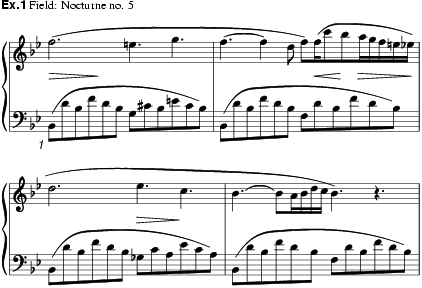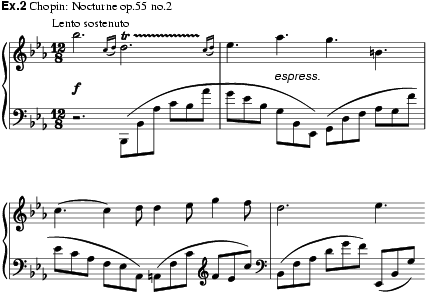
(Fr.; Ger. Nachtstück).
A piece suggesting night, usually quiet and meditative in character, but not invariably so. The Italian term Notturno occurs frequently as a title in 18th-century music, but the French form of the word was not used until John Field applied it to some lyrical piano pieces written between about 1812 and 1836. The first three were published in Leipzig in 1815, two of them having been published in 1812 with minor differences as ‘Romances’. Field’s nocturnes are historically important as antecedents of Chopin’s. The writing is clearly idiomatic, exploiting the sounds available on the newer pianos; the sustaining pedal, in particular, enabled Field to expand the range of the harmonic accompanying patterns beyond those of the Alberti bass, which of necessity lay under the hand. The melodies of his nocturnes transferred to the keyboard the cantilena of Italian opera, to which he had been exposed in Russia in the early 1800s (see ex.1). According to Liszt, who wrote a preface to the first collected edition of Field’s nocturnes (Leipzig, 1859), they ‘opened the way for all the productions which have since appeared under the various titles of Songs without Words, Impromptus, Ballades, etc., and to him we may trace the origin of pieces designed to portray subjective and profound emotion’.

Although
the emotional range of most of Field’s nocturnes is not wide, and the phrase
structure sometimes tediously predictable, the restrained elegance of his
musical language and imaginative keyboard figuration made a great impression on
subsequent Romantic composers, especially Chopin, who admired both Field’s
playing and his compositions. Nocturnes were composed by most pianist-composers
of the time, including Liszt (whose famous Liebesträume song
transcriptions were subtitled ‘nocturnes’), Schumann (Nachtstücke
op.23), J.B. Cramer, Czerny, Kalkbrenner, Thalberg, Henri Bertini and Theodor
Döhler among them. Chopin’s 21 nocturnes, however, hold a pre-eminent place in
the history of the genre. The celebrated Nocturne in E![]() op.9 no.2 is perhaps the most similar to
Field’s nocturnes, showing the influence of two of his nocturnes in the same
key in both melody and accompaniment patterns. It was, however, Field’s
Nocturne no.4 in A major, with its agitated, harmonically more complex, central
section, that proved more inspirational for Chopin’s expansion of the form in
his op.9 no.3 and later pieces.
op.9 no.2 is perhaps the most similar to
Field’s nocturnes, showing the influence of two of his nocturnes in the same
key in both melody and accompaniment patterns. It was, however, Field’s
Nocturne no.4 in A major, with its agitated, harmonically more complex, central
section, that proved more inspirational for Chopin’s expansion of the form in
his op.9 no.3 and later pieces.
Chopin’s nocturnes (especially op.48 no.1) display an intensity well beyond the range of Field and a high degree of melodic invention (ex.2). His remarkable harmonic sophistication, too, is often couched in keyboard textures of a contrapuntal complexity that never seems redundant or forced. Moreover, several diverge from Field’s basic ABA formal outline. The otherwise suave op.32 no.1 in B major ends unexpectedly in B minor with an abrupt, recitative-like coda that appears in emotional terms to contradict all that has gone before, while op.15 no.3 in G minor is in a highly unusual AB form with no recapitulation of the initial material.

Although
the apogee of the pianistic nocturne was reached with Chopin, it continued to
be a popular genre. French composers were particularly attracted to the form:
Fauré wrote 13 nocturnes, and Satie, d’Indy and Poulenc contributed to the
repertory. Liszt’s late works include the nocturne En rêve (1885) and
celebrated nocturnes were also composed by Glinka, Balakirev, Tchaikovsky
(op.10 no.1 in F major and op.19 no.4 in C![]() minor), Rimsky-Korsakov (Nocturne in D minor),
Skryabin and Grieg (Notturno in C major op.54 no.4). Nocturnes were also
written for orchestra; a well-known example is in Mendelssohn’s incidental
music for A Midsummer Night’s Dream, where the tone-colour of the horn
is used, as in the 18th-century notturno, to evoke the image of night. Bizet
wrote an unpublished nocturne for orchestra, and Debussy’s Trois nocturnes
(Nuages, Fêtes and Sirènes, the last with a female wordless
chorus) are among the finest achievements of French impressionist music; Fêtes,
a vigorously rhythmic and extrovert piece, considerably expands the usual
associations of the term ‘nocturne’ to portray nocturnal festivities.
minor), Rimsky-Korsakov (Nocturne in D minor),
Skryabin and Grieg (Notturno in C major op.54 no.4). Nocturnes were also
written for orchestra; a well-known example is in Mendelssohn’s incidental
music for A Midsummer Night’s Dream, where the tone-colour of the horn
is used, as in the 18th-century notturno, to evoke the image of night. Bizet
wrote an unpublished nocturne for orchestra, and Debussy’s Trois nocturnes
(Nuages, Fêtes and Sirènes, the last with a female wordless
chorus) are among the finest achievements of French impressionist music; Fêtes,
a vigorously rhythmic and extrovert piece, considerably expands the usual
associations of the term ‘nocturne’ to portray nocturnal festivities.
In
some of the works already mentioned the effusive lyricism that had
characterized many of the nocturnes of Field and Chopin was replaced by an
attempt to capture the fevered visions and dreams of the night or to evoke its
natural sound world in musical terms that may be very far from those of the
drawing-room. Schumann’s Nachtstücke illustrate this change of emphasis,
which was pursued much further by 20th-century composers such as Hindemith in
his Suite ‘1922’ for piano (1922), Vaughan Williams in A London
Symphony (1912–13; revised 1920), Britten in the nocturne of his Serenade
for tenor, horn and strings (1943) and Lennox Berkeley in the slow movement of
his Divertimento in B![]() (1943). In the suite for piano Out of Doors (1926) Bartók displayed an
extraordinary sensitivity to the sounds of nature in the movement entitled ‘The
Night’s Music’ with its quiet, blurred cluster-chords and imitations of the
twittering of birds and croaking of nocturnal creatures.
(1943). In the suite for piano Out of Doors (1926) Bartók displayed an
extraordinary sensitivity to the sounds of nature in the movement entitled ‘The
Night’s Music’ with its quiet, blurred cluster-chords and imitations of the
twittering of birds and croaking of nocturnal creatures.
F. Liszt: Über John Fields Nocturne (Leipzig, 1859); repr. in Gesammelte Schriften, iv, ed. L. Ramann (Leipzig, 1882/R); Eng. trans. in Schirmer’s edn of the nocturnes (New York, 1902)
W. Georgii: Klaviermusik (Zürich, 1941, 5/1976)
V. Jankélévitch: Le nocturne (Paris, 1957)
M.K. Ellis: The French Piano Character Piece of the Nineteenth and Early Twentieth Centuries (diss., Indiana U., 1969)
W. Kreuger: Das Nachtstück: ein Beitrag zur Entwicklung des einsätzigen Pianofortestückes im 19. Jahrhundert (Giebing, 1971)
D. Branson: John Field and Chopin (London, 1972)
P. Piggott: The Life and Music of John Field, 1782–1837, Creator of the Nocturne (London, 1973)
Z. Chechlińska: ‘The Nocturnes and Studies: Selected Problems of Piano Texture’, Chopin Studies, ed. J. Samson (Cambridge, 1988), 143–66
N. Temperley: ‘John Field and the First Nocturne’, ML, lvi (1975), 335–40
MAURICE J.E. BROWN/KENNETH L. HAMILTON